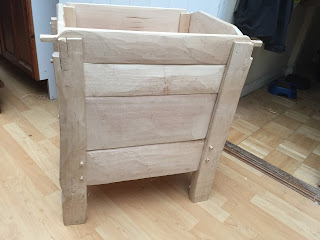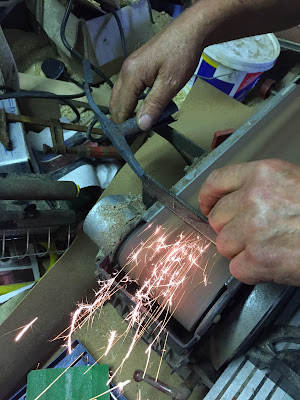 |
| Tamas Gyenes' grooving tool. |
I saw a tool like this being used by a Hungarian woodworker in a 1950's video on Peter Follansbee's green woodworking blog:
https://pfollansbee.wordpress.com/tag/riving/
I decided to try making one of the tools as I might have a go using it to make one of the riven chests still made in Hungary today by Tamas Gyenes using an age old method.
I have a blacksmith friend who has a gas forge in the back of his van who did most of the work. We started with an old 4 pronged garden fork and removed the two middle prongs. Next we bent the two remaining ones at 90 degrees to the handle and hammered a bevelled blade edge on the last 2 inches of their tips.
Then we ground the bevels flat and bent a "U" shape on each tip [over an old file].
The last inch of each blade was then heated to cherry red and doused in water to harden it. I tempered the blades in my home oven at 230c for about 10 minutes. I first cleaned up the steel with a bit of sandpaper so I could see as it changed to a dull straw colour, at which point it was about the right hardness to hold an edge without being too brittle.
I was amazed how well it worked and how easy it was to produce a relatively straight line, even before fitting a handle. The slight curve of each arm relative to the handle seemed to be necessary to stop the tool juddering as it bit into the wood, lowering the angle of attack of the cutting edge. The straight part of the blade seems to help steer the cut in a straight line as it contacts the wood just before the hooked part begins its gouging action.
I made a secondary bevel on both sides of each cutting edge to stop the blade digging in to the timber, in the same way as carving gouges are sharpened.
Finally a handle was added.
Nice to think that this tool applied to the wide edge of a riven board must be the origin of the tongue-and-groove joint still machined into timber today.





















































